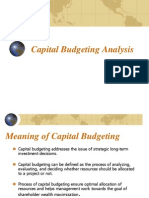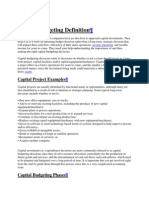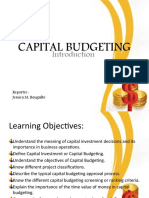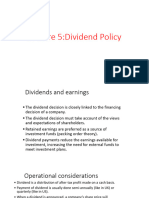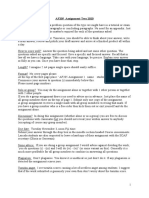0 ratings0% found this document useful (0 votes)
Hurdle Rates Presentation
Hurdle Rates Presentation
Uploaded by
Rohit GargThe document discusses strategic hurdle rates for capital investment decisions. It outlines flaws in using a single hurdle rate or tying the rate to a company's overall cost of capital. The document proposes using different hurdle rates for strategic vs tactical investment decisions, and developing a hurdle rate grid to set different rates for different business divisions based on their returns and competitiveness.
Copyright:
© All Rights Reserved
Available Formats
Download as PPT, PDF, TXT or read online from Scribd
Download as ppt, pdf, or txt
Hurdle Rates Presentation
Hurdle Rates Presentation
Uploaded by
Rohit Garg0 ratings0% found this document useful (0 votes)
The document discusses strategic hurdle rates for capital investment decisions. It outlines flaws in using a single hurdle rate or tying the rate to a company's overall cost of capital. The document proposes using different hurdle rates for strategic vs tactical investment decisions, and developing a hurdle rate grid to set different rates for different business divisions based on their returns and competitiveness.
Original Description:
Hurdle Rates in Financial Fiems
Copyright
© © All Rights Reserved
Available Formats
PPT, PDF, TXT or read online from Scribd
Share this document
Did you find this document useful?
Is this content inappropriate?
The document discusses strategic hurdle rates for capital investment decisions. It outlines flaws in using a single hurdle rate or tying the rate to a company's overall cost of capital. The document proposes using different hurdle rates for strategic vs tactical investment decisions, and developing a hurdle rate grid to set different rates for different business divisions based on their returns and competitiveness.
Copyright:
© All Rights Reserved
Available Formats
Download as PPT, PDF, TXT or read online from Scribd
Download as ppt, pdf, or txt
0 ratings0% found this document useful (0 votes)
Hurdle Rates Presentation
Hurdle Rates Presentation
Uploaded by
Rohit GargThe document discusses strategic hurdle rates for capital investment decisions. It outlines flaws in using a single hurdle rate or tying the rate to a company's overall cost of capital. The document proposes using different hurdle rates for strategic vs tactical investment decisions, and developing a hurdle rate grid to set different rates for different business divisions based on their returns and competitiveness.
Copyright:
© All Rights Reserved
Available Formats
Download as PPT, PDF, TXT or read online from Scribd
Download as ppt, pdf, or txt
You are on page 1/ 14
Group 9
RISHABH RAJ 13PGP104
ROHIT ANAND GARG 13PGP105
RUCHITA RAJU BURDE 13PGP106
SILPA BEHERA 13PGP107
SMRUTI PRAKASH 13PGP109
Strategic Hurdle Rates for Capital
Investment
Concept of a single screen Comparison of expected ROI with the companys cost of
capital
Flaws in the concept
1. Single Hurdle Rate
2. Hurdle rate as cost of capital
3. Investment strategy is a bottom up process
TRADITIONAL APPROACH
Unrelated to availability of funds
Presence of no better options on the table
Impossible to apply to all capital outlays Defensive Investment
Single Hurdle Rate
Problem in defining and measuring operationally the companys cost of capital
Funds provided by investment or reinvestment cannot be considered free capital
Cost of equity as an imputed or opportunity cost
Extrapolation and measurement of ROI standard implicit in stockholders payment
Cost of Capital
PROBLEMS ENCOUNTERED
Corporate Opportunity Cost
In Question?
The relevance of cost of capital to determination of the investment hurdle
rate.
Two conclusions are important here:
Corporate opportunity cost should replace the stockholder opportunity cost for
determining the primary hurdle rate.
Differentiation to be made between Strategic and Tactical investment decisions.
Redeployment of Strategic investment fund involves considerable time and uncontrolled
circumstances.
Two Levels of Choice
Strategic Decision Tactical Decision
Policy level decisions that come out of
long range planning
Smaller per individual proposal that
continue the business on an existing
course.
Concerned with deliberate changes
over a long period allowing for major
transformations.
Concerned with near future with
weightage to past decisions and
present scenario.
Hurdle Rate Grid
In reality, the organization is divided into various segments
which work independent of each other, generate their own
income and have their own set of managers.
Hurdle rate should be analysed for different segments of the
economy.
The strategy deals with the aggregate allocation of capital to
the major segments of the business and defines the
proportions and rate of growth of each relative to the others.
Analysing Divisional Hurdle Rate of
ABC Company
Division Name Current ROI
Contribution to
Earnings
A 8% 50%
B 6% 10%
C 10% 25%
D 12% 10%
E 14% 5%
Total 9% 100%
Hurdle Rate = 11%
Tactical Decisions for ABC Company
Few of B divisions proposals are likely to clear the hurdle
and those that clear have little managerial rationale
To sustain B, some minimum capital commitment is
required to maintain current market potential until decisions
are made to liquidate the division.
Hurdle rate needs to be reviewed for the division B because
of several reasons like market conditions or high
competition etc.
Strategic Decisions for ABC Company
Management can decide whether to maintain, sell or liquidate the
division
Decisions are made not on the divisions capability but on the
expected rate of return on other strategic investment alternatives.
Any decision are made considering the returns of other divisions.
Internal Corporate Opportunity Cost Decisions are made
considering the returns of other divisions.
External Corporate Opportunity Cost - Decisions are made
considering the returns of creating new divisions in the
organization.
Stockholders Interest
Where would we consider stockholders options?
Weak management of a weak company
Rationalize investments that reflects the marginal internal
and external options.
Problem lies in:
Either in the set of investment alternatives selected,
related industry and competitive environment
Caliber of its management
Stockholders Interest (contd.)
Possible Solution
Management change
Altering Strategy
Implications
Setting of over optimistic forecasts.
Investment in high risk ventures.
Stockholders Interest (contd.)
When can it benefit?
The top management use it performance standard for
review.
Only in context of Long range planning.
Budget allocation based on strategic hurdle rates ,which can
be on the basis of:
Internal: Returns of the best performing division.
External: Best of many alternatives outside business.
Budget Allocation based on Tactical Hurdle rates should be
on the basis of:
Internal: Overall demonstrated return of division based on realistic
assessment of targets and past performance.
External measure compares with most efficient competitor.
Conclusion
You might also like
- Solutions Manual: Introducing Corporate Finance 2eNo ratings yetSolutions Manual: Introducing Corporate Finance 2e16 pages
- (Lecture 1 & 2) - Introduction To Investment Appraisal Methods100% (1)(Lecture 1 & 2) - Introduction To Investment Appraisal Methods21 pages
- Financial Perfomance Measures 2023 1510No ratings yetFinancial Perfomance Measures 2023 151045 pages
- Subject Code - MB0045: MB0045 - Financial Management - 4 CreditsNo ratings yetSubject Code - MB0045: MB0045 - Financial Management - 4 Credits10 pages
- Strategic Financial Decision-Making Framework100% (1)Strategic Financial Decision-Making Framework25 pages
- Module - 1: Planning & Analysis Overview: PhasesNo ratings yetModule - 1: Planning & Analysis Overview: Phases43 pages
- (Lecture 1 & 2) - Introduction To Investment Appraisal Methods 2No ratings yet(Lecture 1 & 2) - Introduction To Investment Appraisal Methods 221 pages
- How Do CFOs Make Capital Budgeting and CapitalNo ratings yetHow Do CFOs Make Capital Budgeting and Capital17 pages
- Financial Management-An Overview Oxford Higher Education: Prepared by Sumit Goyal-LPUNo ratings yetFinancial Management-An Overview Oxford Higher Education: Prepared by Sumit Goyal-LPU33 pages
- Principles of Managerial Finance: Capital Budgeting and Cash Flow PrinciplesNo ratings yetPrinciples of Managerial Finance: Capital Budgeting and Cash Flow Principles37 pages
- Capital Budgeting: - Long Term Planning For Proposed Capital Outlays and Their FinancingNo ratings yetCapital Budgeting: - Long Term Planning For Proposed Capital Outlays and Their Financing33 pages
- Lecture 1 Introduction Financial Management PDFNo ratings yetLecture 1 Introduction Financial Management PDF29 pages
- Vladimir Tingue - Formulation of Functional StrategyNo ratings yetVladimir Tingue - Formulation of Functional Strategy11 pages
- Performance Measurement: ©2020 John Wiley & Sons Australia LTDNo ratings yetPerformance Measurement: ©2020 John Wiley & Sons Australia LTD50 pages
- Profitability & Liquidity Ratio AnalysisNo ratings yetProfitability & Liquidity Ratio Analysis19 pages
- Financial Statement Analysis - ApplicationsNo ratings yetFinancial Statement Analysis - Applications12 pages
- Corporate Valuation and Financial Planning (1)No ratings yetCorporate Valuation and Financial Planning (1)36 pages
- Chapter Seven Decentralization and Transfer PricingNo ratings yetChapter Seven Decentralization and Transfer Pricing40 pages
- Formulation of Financial Strategy: Week #3No ratings yetFormulation of Financial Strategy: Week #317 pages
- Long-Term Financial Planning and Growth: Mcgraw-Hill/IrwinNo ratings yetLong-Term Financial Planning and Growth: Mcgraw-Hill/Irwin10 pages
- Capital Structure and Its Theories: Bushra ShazliNo ratings yetCapital Structure and Its Theories: Bushra Shazli50 pages
- Subject: Financial Management Topic: Capital BudgetingNo ratings yetSubject: Financial Management Topic: Capital Budgeting6 pages
- Corporate Finance - SIGFi - Finance HandbookNo ratings yetCorporate Finance - SIGFi - Finance Handbook17 pages
- CAIIB-Financial Management-Module B Study of Financial Statements C.S.Balakrishnan Faculty Member SPBT CollegeNo ratings yetCAIIB-Financial Management-Module B Study of Financial Statements C.S.Balakrishnan Faculty Member SPBT College39 pages
- The Balanced Scorecard (Review and Analysis of Kaplan and Norton's Book)From EverandThe Balanced Scorecard (Review and Analysis of Kaplan and Norton's Book)4.5/5 (3)
- Book Review - Muhammad Salman EE-126 PDFNo ratings yetBook Review - Muhammad Salman EE-126 PDF1 page
- Sustaining Success: The Latest Revision To ISO 9004 Focuses On Organizational SuccessNo ratings yetSustaining Success: The Latest Revision To ISO 9004 Focuses On Organizational Success3 pages
- The Indirect Method For Cash Flows From Operating ActivitiesNo ratings yetThe Indirect Method For Cash Flows From Operating Activities1 page
- Intro Production Use End-of-Life Finish Start: Eco Indicator CalculatorNo ratings yetIntro Production Use End-of-Life Finish Start: Eco Indicator Calculator11 pages
- Applied Economics 1 Week 1 10docx PDF FreeNo ratings yetApplied Economics 1 Week 1 10docx PDF Free9 pages
- Lecture Notes On Mathematics For Business: International School of Business, UEH, VietnamNo ratings yetLecture Notes On Mathematics For Business: International School of Business, UEH, Vietnam162 pages
- Chapter 4 - Completing The Accounting CycleNo ratings yetChapter 4 - Completing The Accounting Cycle59 pages
- Creating Shareholder Value: A Guide For Managers And InvestorsFrom EverandCreating Shareholder Value: A Guide For Managers And Investors
- Solutions Manual: Introducing Corporate Finance 2eSolutions Manual: Introducing Corporate Finance 2e
- (Lecture 1 & 2) - Introduction To Investment Appraisal Methods(Lecture 1 & 2) - Introduction To Investment Appraisal Methods
- Subject Code - MB0045: MB0045 - Financial Management - 4 CreditsSubject Code - MB0045: MB0045 - Financial Management - 4 Credits
- (Lecture 1 & 2) - Introduction To Investment Appraisal Methods 2(Lecture 1 & 2) - Introduction To Investment Appraisal Methods 2
- Financial Management-An Overview Oxford Higher Education: Prepared by Sumit Goyal-LPUFinancial Management-An Overview Oxford Higher Education: Prepared by Sumit Goyal-LPU
- Principles of Managerial Finance: Capital Budgeting and Cash Flow PrinciplesPrinciples of Managerial Finance: Capital Budgeting and Cash Flow Principles
- Capital Budgeting: - Long Term Planning For Proposed Capital Outlays and Their FinancingCapital Budgeting: - Long Term Planning For Proposed Capital Outlays and Their Financing
- Vladimir Tingue - Formulation of Functional StrategyVladimir Tingue - Formulation of Functional Strategy
- Performance Measurement: ©2020 John Wiley & Sons Australia LTDPerformance Measurement: ©2020 John Wiley & Sons Australia LTD
- Chapter Seven Decentralization and Transfer PricingChapter Seven Decentralization and Transfer Pricing
- Long-Term Financial Planning and Growth: Mcgraw-Hill/IrwinLong-Term Financial Planning and Growth: Mcgraw-Hill/Irwin
- Subject: Financial Management Topic: Capital BudgetingSubject: Financial Management Topic: Capital Budgeting
- CAIIB-Financial Management-Module B Study of Financial Statements C.S.Balakrishnan Faculty Member SPBT CollegeCAIIB-Financial Management-Module B Study of Financial Statements C.S.Balakrishnan Faculty Member SPBT College
- The Balanced Scorecard (Review and Analysis of Kaplan and Norton's Book)From EverandThe Balanced Scorecard (Review and Analysis of Kaplan and Norton's Book)
- Accounting and Finance for Business Strategic PlanningFrom EverandAccounting and Finance for Business Strategic Planning
- Sustaining Success: The Latest Revision To ISO 9004 Focuses On Organizational SuccessSustaining Success: The Latest Revision To ISO 9004 Focuses On Organizational Success
- The Indirect Method For Cash Flows From Operating ActivitiesThe Indirect Method For Cash Flows From Operating Activities
- Intro Production Use End-of-Life Finish Start: Eco Indicator CalculatorIntro Production Use End-of-Life Finish Start: Eco Indicator Calculator
- Lecture Notes On Mathematics For Business: International School of Business, UEH, VietnamLecture Notes On Mathematics For Business: International School of Business, UEH, Vietnam







